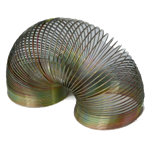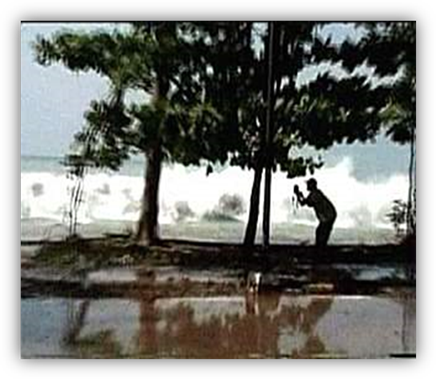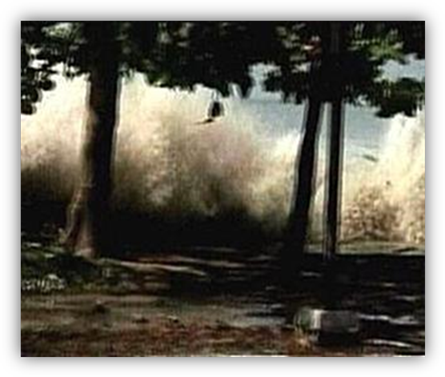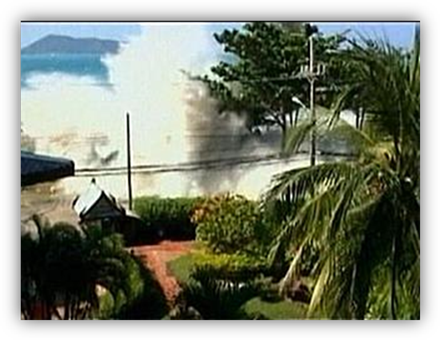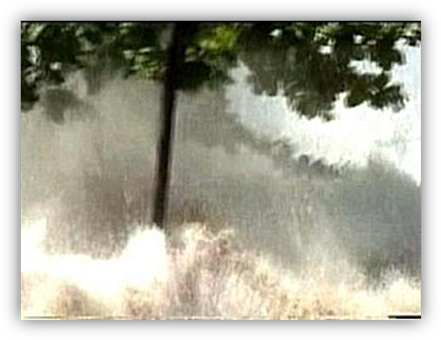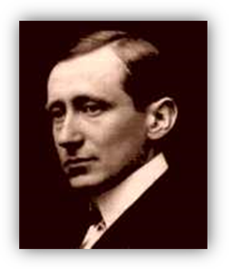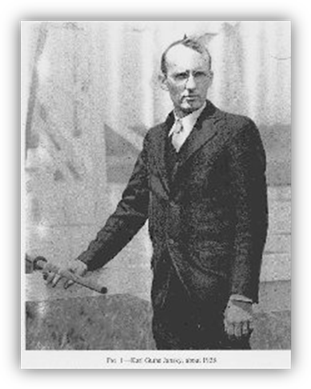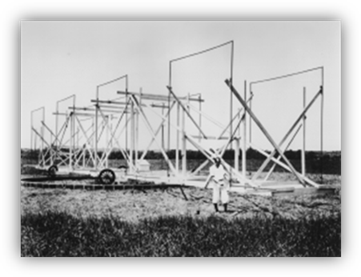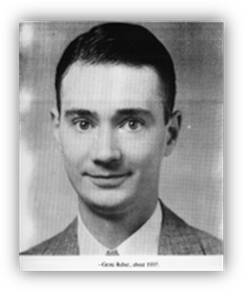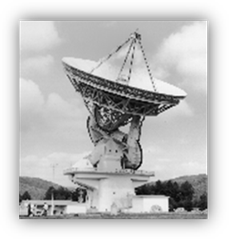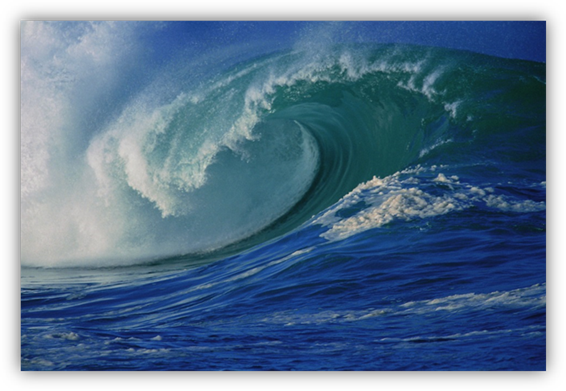
WAVE
ENERGY
Unit Overview
What is wave energy? Do you
think of ocean waves when you think of wave energy? Or do you think of radio
waves? Or maybe even sound waves? A disturbance that transfers energy describes
a wave. Keep in mind that energy is the ability to do work. Wave energy is
energy associated with wave action. Another way to state wave action is to
describe it as a traveling disturbance that moves energy from one location to
another without transferring matter. In this unit we will discuss the two major
classifications of waves, the properties of waves, and the different types of
wave energy. Key words will be in bold type.
|
GLOSSARY
OF KEY TERMS |
|
|
wave |
a traveling disturbance that moves energy
from one location to another without transferring matter |
|
crest |
the highest point, or peak, of the
transverse wave |
|
trough |
valley, or lowest point of a transverse
wave |
|
compression |
area where particles of air are pushed
together as a result of being near something that is vibrating |
|
oscillation |
up and down, back and forth motion |
|
rarefaction |
expanded part of a wave |
|
wavelength |
distance between one crest or peak of a
sound wave and the next crest or peak |
|
radio waves |
longest wavelength, lowest frequency waves
on the electromagnetic spectrum |
|
sound waves |
movement of sound through
the air or other materials in a wave form created by the vibration of some
object and detected by causing a sensor to vibrate |
|
amplitude |
a measurement of the top
(or bottom) half of the wave |
|
frequency |
number of vibrations that occur in one
second |
|
period |
the time it takes for a wave to complete
one full vibration |
|
light waves |
these waves have both electric and magnetic fields |
|
electromagnetic waves |
waves that travel through empty space, a
special kind of transverse wave |
|
wavelength |
the distance between the point of one wave
to the same identical point on the next wave |
|
longitudinal |
a wave whose oscillation is parallel to the
direction in which the wave travels |
|
transverse |
a wave where matter vibrates at right
angles to the direction in which the wave travels |
For extra practice of your
key terms, click on the Key Terms Crossword Puzzle PDF File.
Wave Energy
A wave is a traveling
disturbance that moves energy from one location to another without transferring
matter. A wave does not permanently disturb the medium through which it
travels. But keep in mind that as the wave carries energy it causes the
particles of the medium to vibrate.
There are two major
classifications of waves: transverse and longitudinal waves. A transverse
wave is a wave where matter vibrates at right angles to the direction in which
the wave travels. This definition sounds complicated but it is not. An example
of a transverse wave would be a water wave with the up-and-down or
back-and-forth motion. The up-and-down and back-and-forth motion describes oscillation.
Look at the following web site for a demonstration of both transverse and longitudinal waves: http://www.acs.psu.edu/drussell/Demos/waves/wavemotion.html
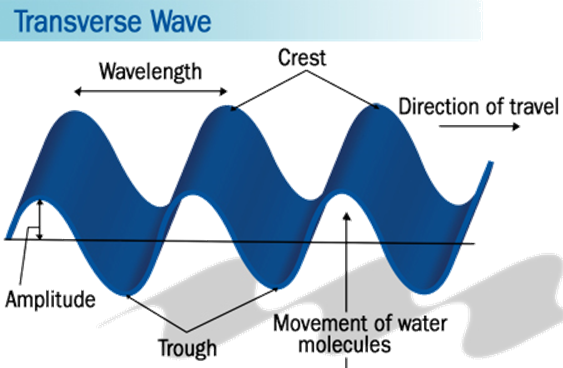
When looking at the above
diagram of a transverse wave, you can see that the highest point, or peak, of
the transverse is called the crest. The valley, or lowest point, is
called the trough. Other examples of transverse waves might include
seismic waves that occur during earthquakes (S-waves or secondary waves) and
electromagnetic waves, or light waves.
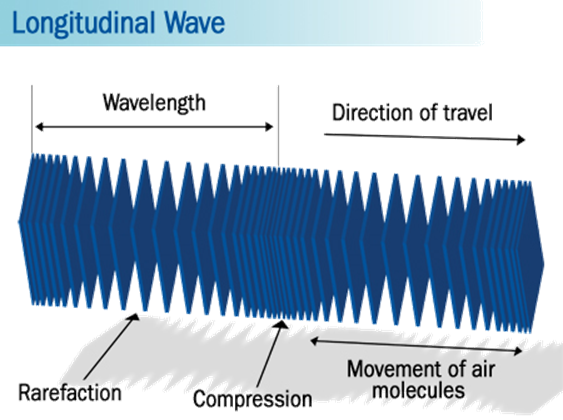
A longitudinal wave is
a wave whose oscillation is parallel to the direction in which the wave
travels. Some examples of longitudinal waves might include sound waves and
earthquake seismic waves (primary waves or P-waves). In longitudinal waves, the
medium pushes close together at some points (compression) and then separates
from each other immediately after (rarefaction). Probably one of the best
examples of longitudinal waves would be sound waves. These are a series of back
and forth oscillations of air molecules and compress and rarefact
in a medium such as water or air. The compressed part of a longitudinal wave,
called the compression, is the crest. A compression is the area of the
medium that is condensed as a result of a force that is being applied to the
medium. The rarefaction, or expanded part of the wave, is the trough.
In both the transverse and longitudinal wave, we see the wavelength. A wavelength is the distance between the point of one wave to the same identical point on the next wave.
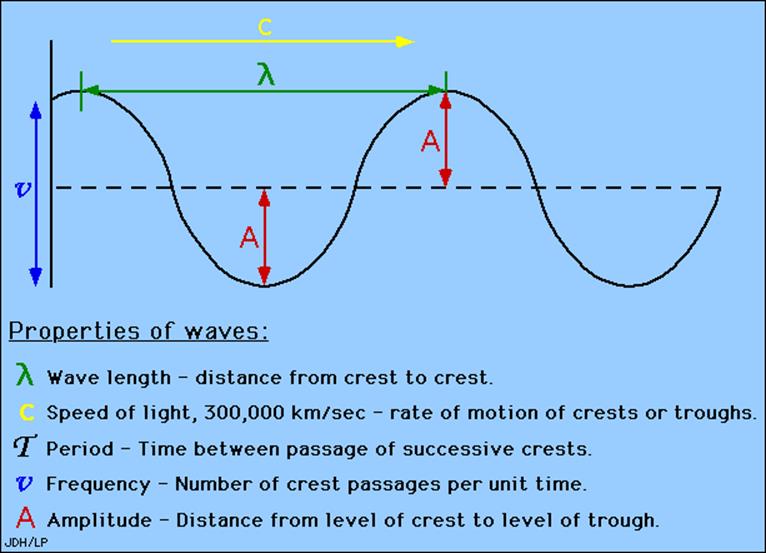
Properties of Waves
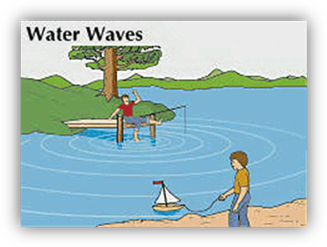 What are
the properties of waves? We would use the type of waves, transverse and
longitudinal, as well as crest, trough, compression, and rarefaction to
describe wave properties. If we are talking about transverse and longitudinal
waves we could also discuss amplitude, frequency, period and wavelength. All
waves have the characteristics listed previously. Amplitude is the
distance from the midpoint to the point of maximum displacement (crest or
compression). Frequency is the number of vibrations that occur in one
second; the reciprocal of the period. Period is the time it takes for a
wave to complete one full vibration; the inverse of the frequency. And you
already know the definition of wavelength.
What are
the properties of waves? We would use the type of waves, transverse and
longitudinal, as well as crest, trough, compression, and rarefaction to
describe wave properties. If we are talking about transverse and longitudinal
waves we could also discuss amplitude, frequency, period and wavelength. All
waves have the characteristics listed previously. Amplitude is the
distance from the midpoint to the point of maximum displacement (crest or
compression). Frequency is the number of vibrations that occur in one
second; the reciprocal of the period. Period is the time it takes for a
wave to complete one full vibration; the inverse of the frequency. And you
already know the definition of wavelength.
( right) Surface
ripples on water, seismic S (secondary)
waves,
and electromagnetic (e.g., radio and light)
waves
are examples of transverse waves.
|
Properties of Waves Experiment |
|
|
|
STEP #1:
Ask your partner to hold one end of the spring toy without moving it. You
will need to hold the other end. Stretch the spring toy to a length of 3
meters along a smooth floor. |
|
STEP #2: Use a side-to-side motion on your
end of the spring toy. Observe what happens. |
|
STEP #3: Continue to make a side-to-side
motion so that one wave, crest and trough, is formed with the entire spring
toy |
|
STEP #4: Move the spring toy twice as fast
as before. Observe what happens. Watch the number of waves that are formed
and the length of each wave. Repeat. |
|
Next, record your
observations from this experiment in questions # 7 - #9. |
Wave Velocity
The velocity of a wave is
dependent upon the medium or type of material in which it is traveling.
Remember that velocity is speed in a given direction. When a wave enters a new
medium, the density and elasticity of that medium may cause a change in the
velocity of the wave. In most cases, the more elastic and dense the medium, the
faster that wave will travel. When the wave is in a particular medium, all of
that type of wave will travel at the same speed.
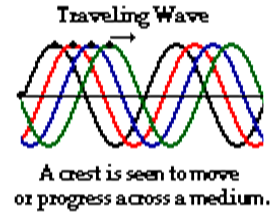
A perfect example of change
in the velocity of a wave occurred during the Tsunami of 2004. As reported in
Time Magazine on January 10, 2005, the wave spread in all directions, moving as
fast as 500 m.p.h. In the deep ocean, the waves were imperceptible (hardly
visible), but they slowed down and gained height as they hit shallow water near
the shore. In deep water tsunamis are very long, shallow waves, which means
they don’t lose much energy fighting gravity. Given enough initial force, they
will travel vast distances until they are slowed by resistance from the sea
floor near shore. Look at the following pictures of the great Tsunami waves as
they approached the shore.
|
|
|
|
|
|
How are frequency,
wavelength, and velocity related?
We already know the
definitions of frequency, wavelength, and velocity, but how are they related?
As long as a wave stays in a medium, the wave speed will continue to remain
constant. Since the wave velocity does not change, under these conditions, the
only variable that might change would be the frequency and the wavelength. If
we were to calculate the wave speed we would use the following equation:
velocity
= frequency x wavelength.
So, if the frequency of a wave has increased,
the wavelength would need to decrease in order for the velocity to remain the
same, or constant. So we could say that the frequency of a wave and the wavelength
are inversely proportional to each other. Inversely proportional is a
mathematical term meaning reciprocal. Sound waves travel at a speed of 331 m/s
in air that is at the freezing point (0 degrees Celsius). As the frequency of
various sound waves change, the wavelengths change too. Look at the chart below
for some examples:
|
VELOCITY
OF SOUND (O DEGREES
C) |
FREQUENCY
(HZ) |
WAVELENGTH
(M) |
|
331 |
128 |
2.59 |
|
331 |
256 |
1.29 |
|
331 |
512 |
0.65 |
In the above chart you can see
that the velocity of sound at 0 degrees C is 331. At a frequency of 128, the
wavelength would be 2.59 m. If the frequency of 128 is doubled, or increased,
the next frequency would be 256. The wavelength would be inversely proportional
to the frequency, and would be decreased by dividing by 2. The answer would be
1.29 m. To get a frequency of 512, 128 would be doubled. Again, the wavelength
is inversely proportional to the frequency and the answer would be 0.65 m. Use
a calculator and calculate these numbers to see if you get the same results. If
you performed your calculations correctly, your answers should be the same.
How are frequency and
period related?
We already know the
definition of frequency, but in other words, it could be described as how many
cycles of a vibration occur per second. It is measured in cycles per second of
hertz (Hz). Hertz is a unit of frequency. The hertz was named after Heinrich
Hertz who proved that electrical signals can be transmitted by electromagnetic
waves that travel at the speed of light. The amount of time it takes a wave to
vibrate one full cycle is the period of a wave. Again, these two terms,
frequency and wavelength, are inversely proportional to each other.
If a wave takes 1 second to
vibrate up and down, the period of the wave would be 1 second. That’s pretty
easy to understand. So the frequency is the reciprocal of that and is 1
cycle/sec. That is because only one cycle occurred in a second. If a wave took
just half a second to again vibrate up and down, the wave period would be 0.5
seconds. The frequency would again be the reciprocal of that wave. The result
would be a frequency of 2 cycles per second. Keep this thought in mind: A wave
with a very short period (such as 0.5 sec) has a high frequency (2 cycles/sec)
and a wave with a long period (such as 1 second) has a low frequency (such as 1
cycle/sec).
Electromagnetic Waves
Waves that travel through
empty space are called electromagnetic waves. Some examples of electromagnetic
waves are light, radio, and x-rays. Electromagnetic waves are a special kind of
transverse wave. They consist of two perpendicular transverse waves. Within
these two transverse waves, there is one component of the wave being a
vibrating electric field and the other is a corresponding magnetic field.
Except for the waves that make up light, all other electromagnetic waves are
invisible.
All electromagnetic waves
travel at the speed of light, which is 300,000 km/sec or 186,000 miles/sec. A particular
type of electromagnetic wave can be defined by its frequency or wavelength. The
waves are arranged in order of wavelength and frequency. The electromagnetic
wave is arranged with a short wave (gamma rays), then short wavelength and high
frequency waves (x-rays and ultraviolet rays), and then a long wavelength and
low frequency wave (infrared radiation, microwaves, radio waves).
Electromagnetic waves differ
from other transverse and longitudinal waves in that they don’t need mediums
such as water, air, or metal to travel through. Other waves such as radio,
gamma, and visible light waves travel easily through the emptiness of space.
Let’s take some time at this
point in the unit to introduce the various types of electromagnetic waves.
Gamma rays are electromagnetic waves with a short wavelength and an extremely
high frequency. Gamma rays are a form of non-visible light. They are given off
from a nucleus as radiation during radioactivity. In fact, they are potentially
the most dangerous of all radioactive rays. Gamma rays kill living cells since
they are radioactive. They are used to sterilize medical equipment by killing
any bacteria that may be forming. Gamma rays, with their high frequency and
energy, can penetrate almost anything, except lead, which has good absorbing
characteristics.
X-rays were discovered in
1895 so they have been around for over 100 years. X-rays can travel through
most objects that are soft but not harder, denser substances. X-rays are used
in medical facilities to obtain shadow pictures or images of various parts of
the body. The use of x-rays is not limited to medical issues, but can also be
used in locations such as airports to scan baggage and suitcases for hidden
objects.
 Radio waves are one part of the electromagnetic
spectrum. They are the longest of the waves that make up the electromagnetic
spectrum. They are made up of a combination of magnetic and electrical fields.
They can be reproduced by an electric current that oscillates rapidly. Radio
waves are measured by the wavelength or frequency. In order for messages, such
as sounds to be carried, the radio waves are altered so that their shape
represents messages. Radio waves were first used by Guglielmo Marconi to
send messages in 1896. Radio waves today are commonly used to broadcast radio
programs. Each radio station uses a specific wavelength that may travel
directly to your radio at home, or may be sent to a satellite to be beamed down
to another part of the world. Radio waves are quite frequently used in two-way
communication with walkie-talkies and mobile (cell) phones.
Radio waves are one part of the electromagnetic
spectrum. They are the longest of the waves that make up the electromagnetic
spectrum. They are made up of a combination of magnetic and electrical fields.
They can be reproduced by an electric current that oscillates rapidly. Radio
waves are measured by the wavelength or frequency. In order for messages, such
as sounds to be carried, the radio waves are altered so that their shape
represents messages. Radio waves were first used by Guglielmo Marconi to
send messages in 1896. Radio waves today are commonly used to broadcast radio
programs. Each radio station uses a specific wavelength that may travel
directly to your radio at home, or may be sent to a satellite to be beamed down
to another part of the world. Radio waves are quite frequently used in two-way
communication with walkie-talkies and mobile (cell) phones.
|
|
|
(1874–1937). The brilliant man who transformed an
experiment into the practical invention of radio was Guglielmo
Marconi. He shared the 1909 Nobel prize in physics for the development of
wireless telegraphy |
Radio waves are not just
limited to being found on Earth. X-rays are a form of invisible light that is
found in space as well. A scientist named Karl Jansky
was attempting to find out if static on some radio telephone lines was being
caused by thunderstorms. Jansky built a moveable
antenna and aimed it at different locations in the sky. This moveable antenna
invention was nicknamed “the merry-go-round” because it could be turned around.
Jansky discovered that most of the static was coming
from radio waves that were produced by thunderstorms. But much to his surprise,
the antenna picked up faint hissing sounds that could not be explained. Jansky became curious and pursued the investigation of
tracking down the hissing sounds.
Even today it seems like magic. You turn on your radio and, somehow, sound sent from a distant radio station fills the room. For almost 100 years radio has allowed us to send sounds over the air.
|
|
|
Karl Guthe Jansky was born in Norman Oklahoma October 22, 1905
(d.Feb.14, 1950), graduated with a degree in physics from the University of
Wisconsin, and joined the staff of the Bell Telephone Laboratories in
Holmdel, NJ, in 1928. Bell Labs wanted to investigate using "short
waves" (wavelengths of about 10-20 meters) for transatlantic radio
telephone service. Jansky
was assigned the job of investigating the sources of static that might
interfere with radio voice transmissions. |
|
|
|
Karl Jansky
built an antenna, pictured here, designed to receive radio waves at a
frequency of 20.5 MHz (wavelength about 14.5 meters). It was mounted on
a turntable that allowed it to rotate in any direction, earning it the name
"Jansky's merry-go-round". By
rotating the antenna, one could find what the direction was to any radio
signal. |
Karl Jansky
continued to observe for another two years. He eventually discovered that as
the stars moved across the sky, so did the hiss. He had discovered that the
radio waves, or hissing sound, were coming from space. His discovery of radio
waves became quite a sensation. After all the excitement of a new discovery
died down, most people seemed to forget about it. Four years later, a man named
Grote Reber, an amateur radio operator, played out a
hunch that Jansky’s discovery was important to the
field of science. Reber assembled a dish antenna in
his backyard with the intention of capturing these radio waves from space. Reber’s dish antenna became the world’s very first radio
telescope. The discoveries of both Jansky and Reber gave scientists a new and improved way of exploring
the sky. Thus, came the discovery of radio astronomy.
|
|
|
Grote Reber was born
in Chicago on December 22, 1911 (d.12/20/2002). He was a ham radio operator,
studied radio engineering, and worked for various radio manufacturers in
Chicago from 1933 to 1947. He learned about Karl Jansky's
discovery (1932) of radio waves from the Galaxy (i.e., the Milky Way), and
wanted to follow up this discovery and learn more about cosmic radio waves.
Were the waves coming only from the Milky Way, or from other celestial
objects? What process produces the radio waves? |
|
|
|
(above) The telescope was constructed by Grote Reber in 1937 in his back yard in Wheaton, Illinois (a
suburb of Chicago). He built the telescope at his own expense while working
full time for a radio company in Chicago. This shows the telescope as it was
in Wheaton, Ill. The mirror, made of sheet
metal 31.4 feet in diameter, focuses radio waves to a point 20 feet above the
dish. The cylinder contains the radio receiver which amplifies the faint
cosmic signals by a factor of many million, making them strong enough to be
recorded on a chart. The wooden tower at the left is used for access to the
receiver. |
Ultraviolet radiation is
another form of wave energy that is part of the electromagnetic spectrum. It
has more energy than light and can cause chemical reactions to take place. An
example of ultraviolet radiation would be the UV rays from the sun. If you were
lying out in the sun on the beach, you would be exposed to UV rays, which in
high exposures, can be harmful to humans. The sun’s UV rays tan the skin by producing
a brown chemical called melanin. High levels of melanin have been known to
cause skin cancer.
Another wave found in the
electromagnetic spectrum is infrared radiation. It is an invisible form of light,
just like ultraviolet radiation. Infrared radiation is given out by anything
hot, including the Sun. It carries the Sun’s heat to Earth, or even the heat
from a fire to you. Rattlesnakes have infrared sensors that can help them
detect body heat. These sensors help a rattlesnake to catch prey at night.
Another way to detect infrared radiation is with an infrared telescope. This
type of telescope provides scientists with important information. The
telescopes can detect heat waves from newly born stars in clouds of dust and
gas. Infrared telescopes even helped discover new comets in our solar system.

Microwaves are short-wave radio
waves. They transmit thousands of signals across a narrow band of frequencies
that is very narrow. Microwaves are used in the communications and technology
fields because they are easy to control and direct. They are difficult to send
long distances due to interference from things like mountains, and buildings,
etc. They are quite frequently used to send telephone, television, radar, and
meteorological communications. Microwave communications are constantly being
used for international telephone calls. Microwave beams are directed to
satellites and then back down to receivers in other countries. One microwave
beam is able to carry more telephone communications than a wire. The most
recognizable form of microwave waves is with the kitchen microwave. In order
for these ovens to function, food molecules vibrate vigorously. This radiation
penetrates through the food, all the way into the middle. All of the molecules
vibrate at the same time, so the food heats and cooks evenly and more quickly
than a conventional oven.
Radar is a technology that
uses microwaves in order to locate distant objects, such as ships and aircraft.
A beam of microwaves is sent out from a transmitter. This beam of microwaves is
reflected off a solid object and picked up again by a receiver. This
information is then transferred into an image on a screen. The image shows
where an object is located and how fast it is moving. Radar is also an
important tool for weather forecasters. Microwaves bounce off drops of rain.
Forecasters are then able to use this information to track bands of rain in
large storms.
Radio waves are not sound
waves, yet they do carry information. They can travel through air, objects, and
even empty space at the speed of light. They can do this without wires or cables.
Today radio waves are used to carry signals for television and radio
programming, telephone calls, and to communicate into space. In fact, radio
waves have even been sent into space to alert any alien life forms (if there
are any out there) about human existence on Earth.
Radio waves are one part of
the electromagnetic spectrum. Electrical and magnetic field combine to make up
radio signals. They can be reproduced by an electric current that oscillates
(changes direction) rapidly. Radio waves are the longest of the waves that make
up the electromagnetic spectrum. They are measured by their wavelength and
frequency. These waves are also measured in hertz (Hz).
Wave Interference
What is wave interference? We
already know that waves carry energy. If the crest of a wave passes a given
point at the same time as the trough of another wave, they can become weakened.
They are considered to be “out of phase” and “interfere” with each other. This
results in a lesser wave height. If the crests of many waves are coming
together at the same time, they are considered to be “in phase” which results
in even more wave height. Waves of water that are “in phase” can quite suddenly
produce a huge wave called a “rogue” wave. A rogue wave has been known to reach
heights of 30 meters. These waves are considered to be freaks of the sea. They
appear all of a sudden out of nowhere and can disappear just as suddenly. This
addition and subtraction of wave crests and troughs is known as wave
interference.
Wave interference can also be
helpful. Scientists and engineers have taken what they know about wave
interference and applied it to modern-day technology. Today engineers are using
wave interference to make earthquake-prone buildings safer. Buildings that
utilize this type of technology are commonly called “smart buildings.” This
building technology was developed in response to buildings being damaged by
earthquake waves. Engineers in the United States and Japan are incorporating
control systems into the designs of some buildings that are located in
potential earthquake zones. The “smart buildings” are capable of detecting and
suppressing their own vibrations to minimize quake damage. During an
earthquake, buildings can sway back and forth with the same frequency of the
earthquake waves traveling through the Earth. A different approach is being
applied today by architects and engineers by developing systems that are
included in the structures of buildings. This technology will be discussed
further in the next unit.
Unit Extensions
Suggested topics for
further research:
·
Radio
Broadcasting
·
Radio
Communication
·
Computer
Technology
·
Earthquake
Waves
·
Earthquake-Proof
buildings
·
Karl
Jansky
- Grote Reber
Careers to explore
·
Seismologist
·
Radio
Broadcaster
·
Astronomer
Unit Conclusion
All waves carry energy, from
water waves, and sound waves, to electromagnetic waves. The types of
electromagnetic include radio waves, microwaves, and other forms. All types of
electromagnetic waves are able to travel through space where there is no air or
matter. The only type of electromagnetic wave that is visible is light. During
this unit, how waves form and how they carry energy has been discussed.
Different types of waves share some common characteristics, such as wavelength
and frequency. Wave energy is important because it enables us to see light and
hear sounds. However, wave energy can be destructive such as with storms and
earthquakes. The future of wave interference is a promising technology and will
help make lives safer.
